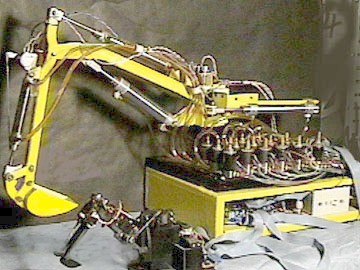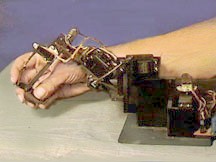MASTER ARM BACKHOE AND HEAVY EQUIPMENT CONTROL

Working Model of the System
High-technology industries have already developed advanced controls
to operate machinery. For example, the nuclear industry developed robotic
arms for handling radioactive components and NASA developed excellent controls
for the giant manipulator arms on space shuttles.
Backhoes, however, are still operated by simple valves that require
extreme operator skill and coordination to handle more than one valve motion
at a time. (Some single lever controls have recently been introduced, but
they do not correspond to the actions of the backhoe and still require
extensive operator training.)
Applied Design Labs proposes the use of space-age technology
to control backhoes and other heavy equipment. This would make the use
of backhoes easier (less operator skills and training necessary) and result
in more efficient productivity with the equipment. In addition, with added
axes such as a rotating bucket in the new backhoes, the machines will be
more flexible and have the ability to do new types of precision digging.
CONTROLS

A worker controls a backhoe using a robotic "master-arm" controller
with position and force feedback like a remote control. The master arm
is a small replica of the actual backhoe and as the operator manipulates
the miniature, the backhoe follows its movements. The replica can be either
mounted in the cab of the backhoe or on a cable or even by radio to allow
the operator to be in a position to see into a hole being dug. This is
a picture of a working model available for demonstration.
THIS SYSTEM IS GREAT BECAUSE:
-
Less operator training: Typically, an untrained person can begin digging
with these controls easily because they are used as intuitively as a shovel.
The only training required would be for placing the backhoe, for use of
the outriggers, and for safety considerations.
-
More efficient in productivity: This system can perform very fast coordinated
movements because it is possible to move all the hydraulic axes at the
same time and speed is only limited by the hydraulics. This means repetitive
movements like scooping material into a truck can be finished in half the
time and after hardly and work.
-
New types of precision earthmoving: Using templates with the master arm
allows shapes to be duplicated with unprecedented precision. A perfectly
level floor can be shaped with the backhoe by following a level board with
the replica arm - even if the backhoe is not leveled! Walls and trenches
can be dug, even if the backhoe is not in line with the wall, just by following
an angled template. Holes for equipment such as transformer vaults can
be formed precisely and with less back-filling by following a custom template.
The use of templates in earthmoving is, to our knowledge, completely new,
proprietary, and innovative.
-
New axes: A rotating bucket is especially valuable for digging trenches
not in line with the backhoe and for cutting slopes at odd angles. Following
a template gives the most control of this rotation when digging at odd
angles with the bucket straight to the cut. Extendable arms are also effectively
controlled. Adding these extra movements just makes the replica easier
to use – instead of more handles to deal with, it just makes the master
arm feel more flexible, whereas in normal hydraulic controls more axes
mean extra valves to operate and think about.
 Click
here to return to our main page.
Click
here to return to our main page.
Copyright © 1999 ADL
Most recent revision August 17, 1999
![]() Click
here to return to our main page.
Click
here to return to our main page.